The history of the shawm
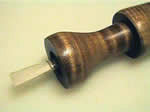
The shawm was a medieval and Renaissance musical instrument of the woodwind familyThe woodwind family is a group of musical instruments that produce sound through the vibration of air in a tube. This family includes flutes (like the concert flute and piccolo), single-reed instruments (such as the clarinet and saxophone), and double-reed instruments (like the oboe and bassoon). Recorders, with a whistle mouthpiece, are also part of this group. While traditionally made from wood, modern woodwinds can be crafted from various materials including metal and plastic, influencing their tone and resonance. Woodwinds are essential in orchestras, bands, and ensembles, known for their diverse range of sounds, from bright and piercing to deep and resonant. They have evolved significantly over time, especially with the development of the Boehm system in the 19th century, which improved their design and playability. Playing woodwinds involves a mix of finger positioning, breath control, and sometimes reed manipulation, allowing for a broad range of musical expression. from the late thirteenth century until the seventeenth century. It is considered the predecessor of the modern oboe. It sound is quite piercing which is why it was mostly used in outdoor ceremonial events where powerful sonorities were needed. By the early sixteenth century, the shawm developed considerably. Its initial harsh tone was mellowed by almost doubling its length. A full consortIn music, the term "consort" refers to a group of instruments played together, typically from the same family. The concept originated in the Renaissance and Baroque periods. A consort is typically a group of similar instruments, such as a group of violas, recorders, or flutes. The instruments in a consort often come in different sizes, allowing for a range of pitches, much like a choir. of shawms provided a truly majestic sound making it adapted for court and royal events even though some of the larger shawms were too cumbersome to be used in processions.
The shawm (as a double reed instrument) has roughly the same ancient ancestors as the bagpipe: the Greek aulos resp. the Roman tibia, derived from the early double-pipes from the Near East. The principal advantage in its structure may be seen in the mounting of the double-reed on the narrow end of a staple (a conical brass tube), while the body of the instrument usually continues the bore-expansion of the staple, ending in a flared bell, similar to that of the trumpet. Virtually nothing is known about the origin and early history of this idea. We may generally assume that a close predecessor of the shawm was the Middle Eastern zurna (or surna), which, according to Mohammedan tradition, was invented in Baghdad in the time of Harun-al-Rashid. It was also made of wood but with a wide disc of metal, bone or mother-of-pearl loosely mounted on the staple against which the player puts his lips allowing the reed to vibrate freely inside the mouth.
The zurna was chiefly a ceremonial and military instrument, played in bands with trumpets and drums. The overpowering noise of these bands had been employed by the Saracens as a psychological weapon. Most likely, the shawm eventually found its way to Europe during the Crusades (eleventh-thirteenth century) but with some remodeling of the top-end into a turned wooden pirouette instead to gain a better lip-control over the reed (see "structure and playing technique").
The first shawms illustrated in manuscripts were usually small and similar in appearance of their oriental counterparts. Early examples appear in the Cantigas de Santa Maria of Alfonsio X" El Sabio" (fig. 1) as well as from the splendidly illuminated Codex Manesse (fig. 2), the most comprehensive source of medieval love songs ("Minnesang") in Middle High German, produced c. 1304–1340 in Zürich at the request of the Manesse family. The early use of the shawm in court and civic music accompanied by drum and trumpetDocumented for instance in 1252 in Siena with an ensemble of three trumpets, cialamella and drum. reflects an Oriental practice perhaps adopted during extensive trading contacts or from the times of the Crusades.
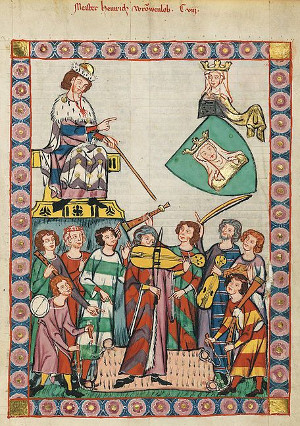
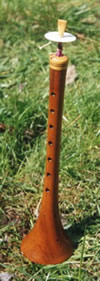
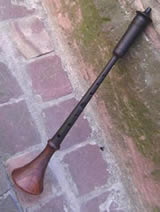
A reconstruction of a Medieval shawm, made of blackwood. Its shrill, piercing sound made it suitable for outdoor performance, especially by military bands.
The Alta and the Town Waits
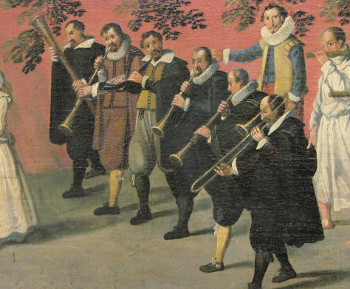
Denijs Alsloot
1616
Museo del Prado, Madrid
The band consists of (from left to right): curtal, tenor shawm, cornett, alto shawm, tenor shawm, trombone
Wind instruments were normally used with great freedom. From about 1300 onwards, during the blossom of the troubadours,Troubadours were a class of lyric poets and performers who flourished in the 11th to 13th centuries, primarily in the Occitan-speaking regions of what is now southern France, but also in northern Spain and Italy. They are best known for their contribution to the development of medieval secular music and poetry. the noisier instruments began to be segregated from those which matched more closely the sound of the human voice and string instruments. This distinction became binding with the greater emphasis on concerted music during the 14th and fifteenth century, perhaps due to the late thirteenth-century interest in Oriental music which distinguished between loud and soft instruments and music (see expert box below). The French alta or haute musique (i.e. "loud music") was used from about the 14th up to the sixteenth century for the groups of shawms, trumpets, trombones, bagpipes and various drums (fig. 3, 4 & 5) as opposed to the basse musique ("soft music") which included recorders, viols, harps, psalteries etc. for indoor performance and the accompaniment of singing.
One of the first mentions of an Alta Capella or Bläser-Alta comes from the court of Burgundy in around 1430, where Johannes Tinctoris (c. 1435–1511) explicitly praised their beautiful sound. The French court band, later called "Les Douze Grands Hautbois de l"Ecurie," instituted under Louis XIII, is documented as having two shawms and two cornetts for the treble parts, four alto shawms for the haute-contre and taille parts, two trombones for the basse-taille and two bass shawms on the basse. The "prestigious noise" of the alta, as it was commonly referred to, must have been played an important part in the court ensemble of Emperor Charles V. In this context "loud" denoted not only the volume but something impressive and spectacular, highly adapted to celebrating the power, fame and splendor of the court. "Es trumett, bließ, pfiff und sang, das einer sein aigen wort nit höret" ("They trumpeted, blew, whistled and sang so that you could hardly hear yourself speak"Sabine Zak, "Musik aus Ehr und Zier," Neuss 1979, pp. 19f.) so the notice of a contemporary witness about the court musicians of Charles V.
From the fifteenth century until the beginning of the nineteenth century, every British town and city of any note had a band of so-called Waites.For details to the history of the Waits in England see Lindsay G. Langwill, "The Waits: A Short Historical Study," in Hinrichson's Music Book, vol. VII (1952), 170–183. See also the extensive The Waits Website. Contrary to common minstrels—normally itinerant players whose capabilities greatly varied—the Waits were trained musicians who served a period of apprenticeship. They were accorded official status with arms to wear and received a regular salary. There was no rule to the number of individual musicians in a Wait, but from four to six were usual, depending on the size and importance of the municipality (London, for instance, had nine Waits).
Originally, members of the Waits were night watchmen or wakemen (hence their name) to "pipe watch" in palaces, castles, camps and walled towns at stated hours in case of alarm. They also signaled the principal times of the day. Another mansion was to wake certain persons at appointed hours by playing under their window. But soon they were required to herald the various processions (both secular and religious) and visits of high-ranking personalities.
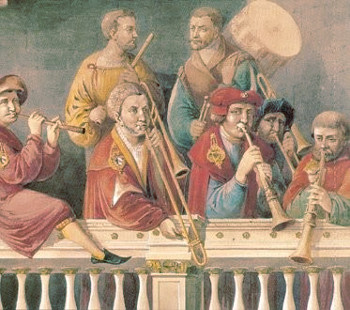
As part of Maximilian's large project of monumental woodcut assemblages named The Triumphal Arch, Large Triumphal Carriage and Triumphal Procession for Maximilian I, executed according to the designs and under supervision by Albrecht Dürer. (To this project and its extensive restoration, click here).* Maximilian I of Habsburg (1459–1519), Holy Roman Emperor 1493–1519,
was the grandfather of Charles V.
Waits generally favored wind instruments since they were best suited for the open air music. The preferred instrument was the shawm or "hoyboy" (from the French "hautbois"), called then "wayte-pipe" or simply "wayte." Furthermore, trumpets, cornetts and afterward the curtal (dulcian) were the common instruments of the Waits. Their summed playing provided an exceptionally rich blend of tonalities. Besides the English and Scottish Waits (see The Bagpipe), the German "Stadtpfeifer" gained great fame in its time.Especially those of Leipzig and Nuremberg (to the Stadtpfeifer see Donald L. Smithers, "Municipal Trumpeters and the Stadtpfeifer," in The Trumpet). In the Netherlands we find the "stadspijpers." Brussels and Antwerp competed with one another to demonstrate their prosperity by maintaining fully equipped official town bands.
The Development of the Shawm-Family
From about 1400 onwards, treble shawms had been extended in length for the lower pitches, called "bombarde," "bumbard" or "pumhart."From Latin "bombu\s": "drone, buzz." These instruments had at least one but often up to four keys to close the lowest hole. The keywork was protected by a slide-on wooden barrel perforated with rosettes, called fontanelle. One of the first illustrations of such a kind of shawm can be observed in the painting Mary, Queen of Heavens (fig. 6) by the Master of the Legend of St Lucy. This led to the development of a true shawm-family (fig. 7). While Sebastian Virdung (Musica getutscht, 1511), Martin Agricola (Musica instrumentalis deudsch, 1529) and Johannes Tinctoris (De inventione et usu musicae, iii, c. 1483) mention only two resp. three sizes ("Schalmey," "Bombardt," "contratenor" [= bass bombard]) we find drawing and description of six members in Michael Praetorius' Syntagma Musicum II (1619).
Master of the Legend of St Lucy
c. 1485–1500
Oil on panel, 199 x 162 cm.
National Gallery of Art, Washington
The encyclopedic combination of "soft" and "loud" music here is unique in fifteenth-century painting.
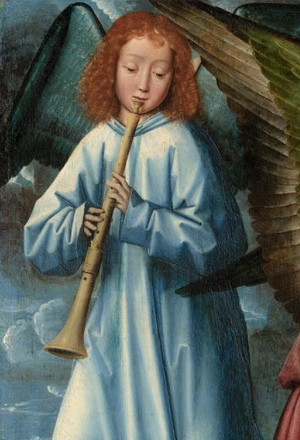
The shawm the angel is playing shows a key under the fontanelle, the wooden barrel perforated with small holes.
Names and approximate sizes of shawms according to M. Praetorius
| German term (Praetorius) | modern terminology | approximate length |
| gar klein Discant Schalmeye |
high treble | 50 cm. |
| Discant Schalmeye | treble (soprano) |
65 cm. |
| Alt Pommer | alto | 75 cm (1 key) |
| Tenor- or Basset Pommer |
tenor | 130 cm (1 key) |
| Bass Pommer | bass | 180 cm (4 keys) |
| GrossBass Pommer |
great bass | 290 cm (4 keys) |
Due to the enormous length of the great bass pommer (nearly three meters!) it could only be played if the bell was rested on the ground or the player was raised onto a platform. Nonethless, they were appreciated for their rich, warm tone.
Shawms were built at intervals of a fifth from each other, which could lead to intonation problems in ensemble playing but normally only two or three members of the family were played together at one time. The gar klein Discant Schalmeye is mentioned only by Praetorius, presumably because of the problems caused by its short length and its impractical disposition of a fifth above the treble.
Click here for period shawm music:
(requires Real Player)
The first part of Pavane La Battaille from Tielman Susato's
Deerde musyck boexken Dansereye (1551), played on cornetts, sackbuts, serpent, rauschpfeife, shawms, curtal, organ, regal, timpani and side drums as an example for a large alta group, expressly employed for great festive occasions.
Performed by New London Consort, directed by Philip Pickett.
The esteem held for the lower shawms is evident in a great number of orders of shawm sets in which the "grosse Pumharts," "dobbele bombaerde," "twee bassetten," or "a Base Shalme" were emphasized. "Indeed of all musical sounds that from day to day smote the ears of a sixteenth-century town resident, the deafening skirl of the shawm band in palace courtyard or market square must have been the most familiar, save perhaps only for the throbbing of a lute through somebody's open window." (A. Baines). Later the cumbersome great bass pommer/bombard was replaced by the "Double Curtall," the early bassoon (see The Dulcian/Curtal).